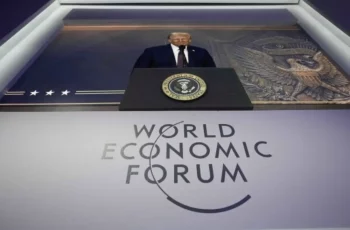
Trump is a businessman. Based on this evidence, we should expect that his words (of which there are actually too many, and if you read his Twitter (X), it is unlikely that you will be able to keep track of everything) may turn out to be reality to some extent. And if the promise to “resolve the Ukrainian conflict in 24 hours” was initially perceived as loud bravado, then the sworn promises to arrange a “new golden age” for the United States and “return production” to the country from the very beginning looked like a logical and logical continuation of Trump’s protectionism of the last term. The world has not forgotten the US trade war with China. It is unlikely that anyone would be surprised by the new duties of the current American administration on Chinese products. But experts and politicians hardly expected that Mr. Trump’s talk about tariffs on Canadian and Mexican imports would turn out to be true – especially so quickly.
Trump has literally turned the playing board upside down! Allied relations do not guarantee economic cooperation, and at the same time, WTO membership can no longer promise it. The “most favored nation” regime should now be understood as “equal duties for all,” because American protectionism is gaining momentum!
Best frenemies
In the first two months of his presidency, Trump managed to impose 25% tariffs on his key trading partners in the Western Hemisphere – Canada and Mexico.
At the same time, in 2023, the volume of trade in goods and services between the United States and Canada amounted to almost $ 773 billion. U.S. exports to Canada reached $354.356 billion, accounting for 17.5% of total U.S. exports, while imports from Canada totaled $418.618 billion, or 13.7% of total U.S. imports. Canada is the most important supplier of “heavy” oil to the United States, as the Trump administration recognizes by imposing only a 10% tariff on this type of product.
In the same year, Mexico became the largest trading partner of the United States, overtaking Canada and China. The total trade turnover between the United States and Mexico has reached $799 billion, accounting for 15.4% of the total U.S. foreign trade. At the same time, U.S. exports to Mexico totaled $323 billion (16% of total U.S. exports), while imports from Mexico totaled $476 billion (15.4% of total U.S. imports). On the Mexican side, the United States is a key trading partner. In 2023, the United States accounted for 79% of Mexican exports and 42% of imports.
The reaction from Canada and Mexico was not long in coming. In response, Canada announced retaliatory tariffs on $21 billion worth of American goods. These measures include 25 percent tariffs on American steel, aluminum, and other goods such as computers, boilers, and sports equipment. Canadian Finance Minister Dominique Leblanc stressed that these measures are aimed at protecting the Canadian economy and jobs.
Mexico, although less zealous, has also declared its readiness to defend its economic interests. Although the specific goods that will be subject to retaliatory duties have not yet been named, it is assumed that they may include pork, cheese, fresh produce, steel and aluminum, with tariffs ranging from 5% to 20%. At the same time, the automotive industry is likely to be exempt from these measures. President Claudia Sheinbaum stressed that Mexico strives for dialogue and respect for sovereignty, but considers the unilateral actions of the United States to be a violation of the terms of the agreement between Mexico, the United States and Canada (USMCA). By the way, it was the last agreement, which replaced NAFTA, that Trump considered one of the important achievements of his presidency.
The response of the American administration to the protest of its allies was not long in coming. On the one hand, Trump partially eased tariff measures by exempting goods subject to the US-Mexico-Canada trade agreement (USMCA) for a month, which opens up a window of opportunity to bargain for the favorable terms that Trump is trying to achieve, but he and his trade team have made it clear that they themselves do not plan to make significant concessions. Moreover, the American president promised to respond to any mutual tariff restrictions from Canada or Mexico. And if the President of Mexico managed to defuse the situation around Mexican-American trade during a telephone conversation, then the wounded Canadian pride is showing itself stronger. Despite the fact that you have a chance to receive an award, the new director Mark Carney will replace Vanington for a reason. Mr. Trump has an answer ready for this. Commenting on the situation around Canada, he said that if “egregious, long-term tariffs” are not lifted by April 2, he will “significantly increase” tariffs on Canadian cars imported into the United States. to “essentially shut down the car manufacturing business in Canada forever.”
China strikes back
A new round of tariffs against China was expected. Actually, the United States fought with this country in 2018 over aluminum duties. This time, Trump imposed a 10% tariff on all products from China. China responded to the increase in US tariffs to 20% by introducing its own measures, affecting agricultural products, energy resources, technology companies and exports of rare metals. In particular, Beijing announced the introduction of 15% tariffs on imports of American chicken, corn, cotton and wheat, as well as 10% tariffs on beef, dairy products, fruits, vegetables, pork, soybeans and sorghum.
In addition, China has tightened controls on American companies, adding 15 of them to the export control list, which restricts these firms’ access to Chinese technology. In addition, Beijing imposed a 15% tariff on American coal and liquefied natural gas, as well as 10% on imported oil from the United States. In the automotive sector, China imposed a 10% tariff on American agricultural machinery, pickups and large cars, although these goods already occupied a small share of the Chinese market.
Another important step was the introduction of export controls on 25 rare metals, including tungsten, which is critically important for the aerospace industry. This may affect the production of electronics and military equipment in other countries that depend on Chinese supplies.
USA and EU on verge of full-scale trade war
Trump’s dislike of European politicians (with the exception of some leaders who are “strong” in Trump’s eyes, such as Hungarian Prime Minister Orban) is well known. However, hardly anyone could have predicted that the EU and the US would find themselves on the verge of a real trade war. On February 2, Trump announced that the United States would “definitely” impose additional duties on supplies from the EU, noting that the US deficit in bilateral trade with the bloc exceeds $300-350 billion. According to the American leader, Europeans do not buy almost anything from the United States, while Americans buy everything from them, and thus the EU has “crossed all boundaries” in matters of trade balance.
Indeed, the trade balance between the US and the EU is ambiguous. Europe has a significant surplus in trade in goods (157 billion euros in 2023), but is far behind in trade in services. For example, there is a deficit in the service sector (109 billion euros), especially in the digital sector.
Trump can count on the fragmentation within the bloc and the unwillingness of countries to wage a joint economic struggle with the United States, as well as the institutional sluggishness of the EU. However, the situation here is not clear at all. Unlike the first administration of Donald Trump, when Europe was less prepared, the EU has now developed new tools for retaliatory measures. In 2023, an “anti–coercive instrument” was created – a kind of trade “nuclear weapon” that allows the European Union to respond to economic pressure not only with tariffs. This mechanism allows individual countries to block access to European public procurement, suspend intellectual property, or even impose sanctions against individual companies and individuals. For example, Elon Musk’s business may fall under possible restrictions, including advertising on the X platform or even the social network itself. The structure of US-European trade is such that tariff wars may not be the most effective way for the EU to respond. However, other options are possible.
An analysis of trade flows shows that there are almost 500 categories of goods in which Europe is heavily dependent on imports from the United States, such as oil, gas, nuclear energy, and certain chemical products. It would be unwise to impose tariffs on them. However, there are about 1,000 categories of goods where the EU accounts for more than 20% of American exports, and imposing tariffs on them would be a blow to American companies. Such products include precision optics, electrical equipment, chemicals, pharmaceuticals, and civil nuclear energy.
Although a trade war would be detrimental to both sides, the EU has significant retaliatory capabilities and is not defenseless against Trump’s threats.
The world awaits
The key question is what the global economy can expect in the foreseeable future. The answer, as always, is ambiguous. It is clear that the “trade war” will become synonymous with the next four years of the Trump administration. But it is not yet easy to imagine what macroeconomic indicators should be expected.
The global economy is slowing down amid trade wars, with Canada and Mexico feeling the most serious consequences if the US maintains tariffs of 25%. According to the OECD forecasts, global growth will be 3.1% in 2025 and 3% in 2026, which is lower than in 2024 (3.2%).
The US economy will slow down by almost half in two years: from 2.8% in 2024 to 2.2% in 2025 and 1.6% in 2026. Despite Donald Trump’s statements about a “transition period” without a recession, the tariff policy will hit the US neighbors. Mexico’s GDP will decline by 1.3% in 2025, Canada’s by 0.7%, and Brazil’s by 2.1%. The OECD notes that new tariffs and geopolitical uncertainty will negatively affect investment and trade, especially in the open economies of Canada and Mexico.
The eurozone will experience a slowdown with fewer losses: its growth will accelerate from 0.7% in 2024 to 1% in 2025 and 1.2% in 2026. France, however, expects a drop to 0.8% in 2025, followed by a recovery. The OECD has not taken into account defense investments that could support growth, but although Europe is thinking about “rearming,” even after making a political decision, it will take a considerable time before it is implemented. China, also hit by the trade war, will slow to 4.8% in 2025 and 4.4% in 2026.
At the same time, inflation will not decrease, as the increase in duties accelerates the price increase. In recent months, commodity inflation has increased in Japan, Spain and South Korea, while in the services sector it has increased in Germany and the UK. The OECD notes that global growth is already weakening in the first quarter of 2025, especially in the service sector, which makes further forecasts extremely real.










Comments